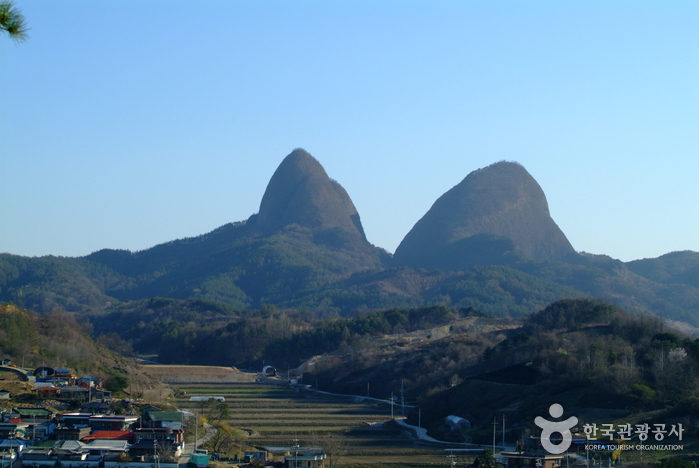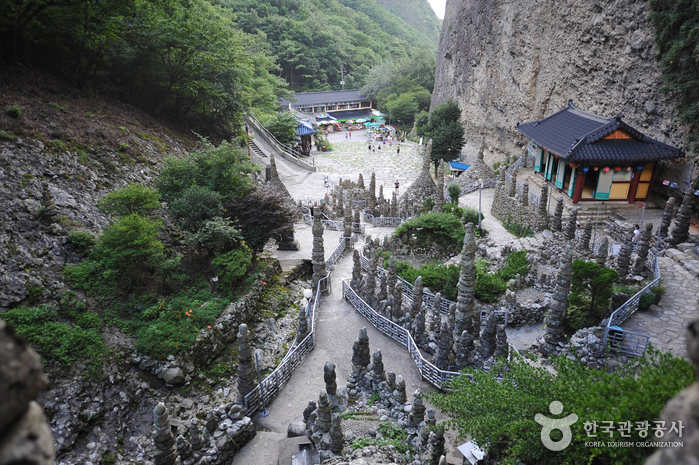Tour near or inside Jeonju
Looking at Mai Mountain from the south, you can see small cave-like features on the steep slopes halfway up the mountain, just as if they were bombed. These features are called tafoni (also referred to as honeycomb weathering). Weathering usually occurs on the surface of rocks, but the tafoni on Mai Mountain occurred from within the rocks, expanding internally to push out the rocks' surface. This is one of the most well-developed tafoni features in the world.
The 100 million year old mystery is very much pleasing to the senses. Mai Mountain was easily overlooked with the simple story that the mountain looks like a horse's ear without acknowledging its mysteries, legends and histories of nature kept in it. Mai Mountain, the only double peaked mountain in the world, is at the center of Jinan Heights on the boundary of the Noryeong Mountains, approximately 32km to the east of Jeonju and 3km to the southeast of Jinan-Eup. The whole mountain consists of the sedimentary rocks. The female Mai peak of 673m and the male Mai peak of 667m form the backbone of the Geumgang and Seomjingang rivers. ( http://www.jinan.go.kr/english/)

Tapsa, in Jinan-gun, Jeollabuk-do, is an example of the amazing accomplishments an individual can achieve when properly motivated. Tapsa is a temple where a man named 'Gapryong Lee', a retired scholar built numerous pagodas one stone at a time over a period of decades. There are some marvelous towers, such as Cheonjitap, Obangtap, Ilgwangtap and Wolgwangtap, which are so tall and massive it's hard to believe they were erected by just one man. It is said that he built 108 towers over 30 years from 1885, but only 80 of them remain today.

The culturally abundant city of Jeonju can be found in the middle of the Korean peninsula. This historical city dates back to the Baekje Kingdom. Gyeon Hwon founded the nation after the dissolution of the three kingdoms in 892. Jeonju became the capital city, and provided present day Jeonju full of many treasures including a Traditional Korean village. It is recommended that tourists visiting Jeonju, begin at this unique village. The village area includes a traditional hot spring and is surrounded by many popular tourist spots. This is a must-see for foreign tourists. The Joseon Dynasty was founded by Taejo Yi Seong-gye. His portrait is enshrined in this city. Other cultural gems include Pungnammun Gate, Jeonju Confucian School, Jeonju Traditional Life Experience Park, Jeonju Traditional Craftworks Exhibition Hall, Jeonju Treasures Center, Gangam Calligraphy Museum, Jeonju Traditional Culture Center, and Jeondong Catholic Cathedral, well known in Korean Catholic history. In addition, the Jeonju Traditional Culture Center gives visitors the unique experience of life in a traditional Korean house, known as 'Hanok' in Korean. The Jeonju Hanok Living Experience Center also gives visitors traditional style accommodations in a comfortable setting. This is a great experience for foreigners.
Jeonju Hanok Village, an international slow city, is the largest Hanok (Korean-style house) village in Korea located in an urban center. The breath of Korea's history, from the Joseon Dynasty to the modern era, is reflected in the Hanok Village, which is an actual, functional village with many current residents. Providing various opportunities to experience traditional cultures with more than 700 Korean-style houses, Jeonju Hanok village won the Korea Tourism Awards in 2010, and was also selected as the best tourist attraction in 2011 by the Korean Ministry of Culture, Sports & Tourism.
![Jeonju Hanok Village [Slow City] (전주한옥마을 [슬로시티])](http://tong.visitkorea.or.kr/cms/resource/47/898547_image2_1.jpg)
